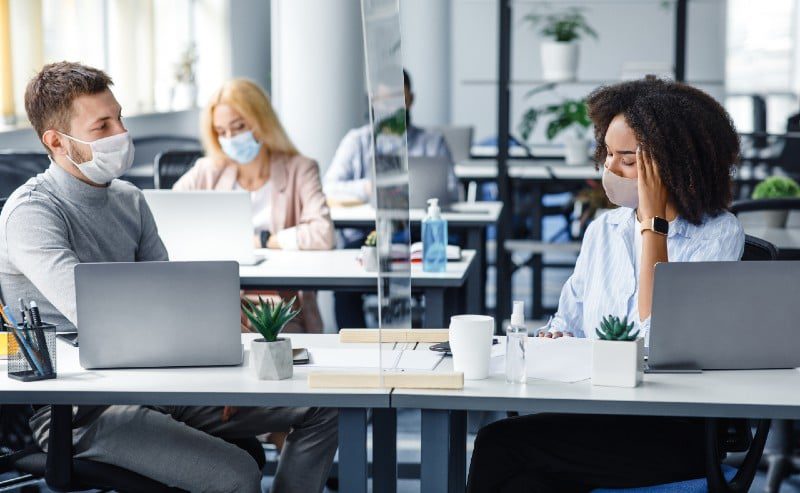Table of Contents
Updated on May 13, 2024
I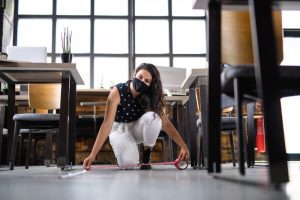

It’s evident the workplace people once knew is going to look a lot different to the way it was before.
In fact, as many employees start to think about a return to the workplace in both the immediate and distant future, the change is something that needs to happen in order to protect people from future illnesses.
Although the pandemic is far from over and restrictions will be in place for some time, businesses are gradually opening up and bringing employees back.
However, after such a long time working at home for many employees the thought of returning to work can be anxiety inducing.
Contact us to learn how we can help you create a healthier workplace
Employee Anxieties Around Returning to the Workplace
On one hand, the change in routine can be the thing that causes the most anxiety. Employees have become used to working from home and the thought of being away from home and working in an almost new environment can be worrying.
For many, it’s the concern around contracting covid-19 that is causing the most worry. In a study by KPMG, it was found that 54% of Canadians are afraid return to the workplace due to how contagious the coronavirus is while 60% will refuse to go back if they feel that the workplace isn’t safe enough.
In another survey, it was also found that 60% of workers would actually take a lower paying job if it meant having a healthier working environment too showing just how important hygiene and health is to people now.
These statistics represent that it’s vitally important for businesses to ensure the workplace is safe so people feel confident about going back to work. If adequate steps aren’t taken, businesses could risk a reduction in productivity, employee engagement and happiness and a rise in absenteeism from stress or through illness.
So, what measures can be taken to ensure a safe and clean bathrrom environment and minimize any anxieties?
Simple Steps to Create a Safe Workplace and Provide Peace of Mind
Even after covid, many employees will continue to work remotely however for many workers who miss relationships and face to face communication with colleagues, going back to work will be welcomed. Only if the right measures are implemented though. So, what steps can be taken?
Measures to Reduce Anxieties
- Talk to your employees. Find out directly from your employees what they want to see in order to ensure they feel safe and confident about returning to the workplace.
- Have open conversations with employees about how they are feeling about going back to work and how you can help them adapt to the workplace.
- Consider a phased approach when bringing employees back. This may also be needed to allow for effective social distancing. A phased approach may include bringing employees back in stages or may involve employees working some days at home and some days in the workplace.
- Make the office feel like home. This could be something you haven’t considered before but may need to now, to reassure staff and help them cope with the change in environment. Adding plants for example can help to create a homely environment while it can also have an impact on productivity due to the increased oxygen. Having set ‘quiet areas’ in your workplace could be beneficial too so employees can concentrate without distractions if they need this.
- Communicate hygiene and safety measures that are being implemented. You can take all the necessary steps but if employees don’t feel like the environment isn’t safe then they won’t be reassured. This is where communication is key. Holding staff meetings to share what actions are being taken or displaying cleaning schedules can be a couple of ways to communicate latest safety measures.
Measures to Ensure a Hygienic and Safe Working Environment
Hygiene and wellness go hand in hand. Key to providing peace of mind is ensuring the workplace is safe and hygienic. With the importance of hygiene being emphasized and being higher on the agenda than ever before, these measures will not only help bring employees back to the workplace, but they will be invaluable to future success too.
- Stagger the working day for employees with different start/finish times and lunch break hours. This can help to maintain social distancing and ensure workers aren’t all congregating around the water cooler at the same time.
- Consider what changes to the current layout of the workspace are needed to maintain social distancing. Measure out the distances between desk spaces and see where alterations need to be made.
- Say goodbye to hot desking. Hot desking may have to very much be a thing of the past now. Covid-19 and other respiratory illnesses can easily be contracted through contact with contaminated surfaces. Ensuring employees have their own equipment to avoid touching shared equipment is just one of the ways to minimize the risk of infection transmission.
- Sanitation and cleanliness has been cited as one of the main reasons people may avoid returning to the workplace. It’s never been more important to make sure workplaces not only look clean but are clean too. Review your business’ daily, weekly and monthly cleaning schedules to ensure all areas of the workplace have been thought about. Professional disinfection can also provide additional protection from viruses and bacteria.
- Install non-contact infrared thermometers to take temperatures of staff upon arrival to avoid potentially ill employees coming into the work environment and spreading it further.
- The importance of air care shouldn’t be overlooked either. The WHO advise that there should be fresh, clean air in every workplace so while commercial air fresheners can help reduce malodours and clean the air, air purification systems can actually treat the air to get rid of any viruses, bacteria and dust that may risk the health of your employees.
- Move to touch-free washroom products. While washing your hands after using a manual dispenser can ensure you don’t pick up germs, many people would feel more confident in using touch-free dispensers and solutions such as automatic flushes due to the perceived risk of using manual dispensers. Making the move to touch-free can reassure staff that you take hygiene seriously as well as encourage good hygiene practices.
- In addition to touch-free washroom solutions, automatic doors could help to reassure employees that you are providing a safe environment. In a recent survey, it was found that 47% of adults said they would feel comfortable in using a public washroom if there was something to open the door with other than your hand.
- Provide PPE disposal bins. PPE will continue to be worn for some time and this may include in the workplace itself. Providing disposal bins specifically for PPE waste can help to create a safe environment and show employees you care about their health.
More guidance on creating a safe environment can be found on the Government website and through the World Health Organization (WHO).
Slips, Trips, and Falls at Work
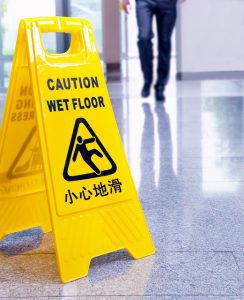
Some of the most common workplace accidents in the U.S. and Canada include slip-and-falls, reaction injuries (slips and trips without falling), and contact injuries (with objects, equipment, or walking into something). The average slip-and-fall accident can cost upwards of $20,000 and result in several days away from work. About 65% of falls occur on same-level surfaces, so proper floor safety matting to keep floors dry, and housekeeping to clean spills and remove clutter will go far in preventing these mishaps.
Being Smart with Sharps
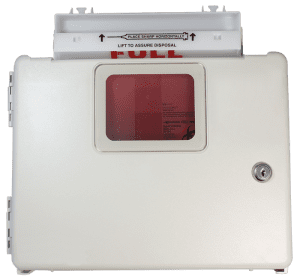
OSHA’s 1910.1030 standard regarding exposure to bloodborne pathogens requires employers whose staff may be exposed to potentially infectious body fluids to provide the necessary equipment to minimize this risk.
Some industries, like healthcare, need sharps disposal containers. However, all other businesses with employees who use sharps to treat medical conditions should also consider providing disposal. Many people use sharps (needles, lancets, syringes, or scalpels) to treat medical conditions like diabetes, migraines, cancer, and allergies. Improper disposal of used sharps in could lead to accidental exposure and needlestick accidents. Purchasing a sharps unit and using our sharps disposal service with Citron Hygiene ensures safe, compliant disposal and comes with regular maintenance, so containers never become too full.
Cardiac Arrest & Pandemic Planning at Work
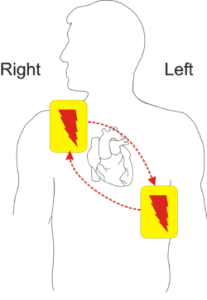
Two other events that businesses should consider preparing for are cardiac arrests at work, and influenza pandemics. Each year, there are about 40,000 cases of cardiac arrest in Canada and in the U.S., around 10,000 instances of this happen to people while they are at work. An AED (automated external defibrillator) may not be used at all, but having it there shows employees and guests that their safety and health matters.
Illnesses are considered a safety issue for businesses as they can affect a large number of people quickly, and cause great disruption in productivity and become costly to manage. Pandemics are a large-scale, worst-case scenario version of an outbreak in the workplace. They are defined as “unpredictable, but recurring events that can cause severe social, economic, and political stress” by the World Health Organization. Absentee rates can be as high as 30% during peak pandemic periods, but having a plan and supplies in place could lessen this.
At Citron Hygiene, ‘Building Healthy Spaces’ means more than providing a fresh, clean environment for our clients?? staff and guests, it means preserving the health of everyone who visits the locations we serve. For this reason, we offer life safety services that can be adopted by businesses large and small.
Schedule a free consultation with our friendly team, and find out how we can help your business get life and pandemic plans in place.
The Importance of Hand Hygiene in the Workplace


Making sure your business is providing effective hand hygiene solutions such as soap and water is essential. Where providing soap and water is not possible, hand sanitizer stations should be placed around the workplace in high traffic areas such as entry and exit points or at office desks. Rather than having hand sanitizer lying around on makeshift tables, making sure soap or sanitizer is stored in closed cartridge dispensers like the Gojo soap dispensers presents a better impression and is more hygienic too.
Alongside hand hygiene stations, signage can remind and educate people on proper technique as if not performed properly; the benefits of hand hygiene will be reduced.
Download our free hand hygiene display posters
How to Wash your Hands with Soap and Water Poster
How to Properly Sanitize Your Hands Poster
Please Use Me Hand Sanitizer Poster
More Resources to Help you Create a Safe Workplace
As experts in hygiene, we have put together a number of other resources designed to support your business in creating a safe workplace for all who come and go.
Check out our range of resources that can help your business.
How Does Your Washroom Rank – A Free Scorecard
How to Dispose of PPE Effectively
Sector Guidance
Hygiene Guide for Manufacturing Companies
We are continually updating our collection of resources so if your business requires any more specific advice, get in touch with our team.
Build a Healthy Space in Your Organization – Request a Free Facility Hygiene Consultation
Creating a safe workplace is going to be vital to success moving forward in order to instil confidence in employees, customers and visitors. This is why Citron Hygiene are offering free facility hygiene consultations to help businesses assess what permanent solutions they could benefit from for a safer workplace overall.
Contact us to book your consultation or call our team on 800.643.6922
Related posts:
- Ensuring Workplace Safety: Key Strategies for Business Preparedness
- Hair, Nail Salon Hygiene Tips And Good Practices [2023]
- How Does School Environment Affects Teacher Wellness?
- Workplace Washroom Cleanliness And Safety – Tips & Solutions
- Hygiene & Cleanliness In A Supermarket – Tips, Good Practices
- Supporting Life Safety in Schools
- Are Hand Dryers Hygienic? Myths & Importance Of Hand Dryers
- What Are The Hygienic Advantages of Touch-Free Hand Dryers?
